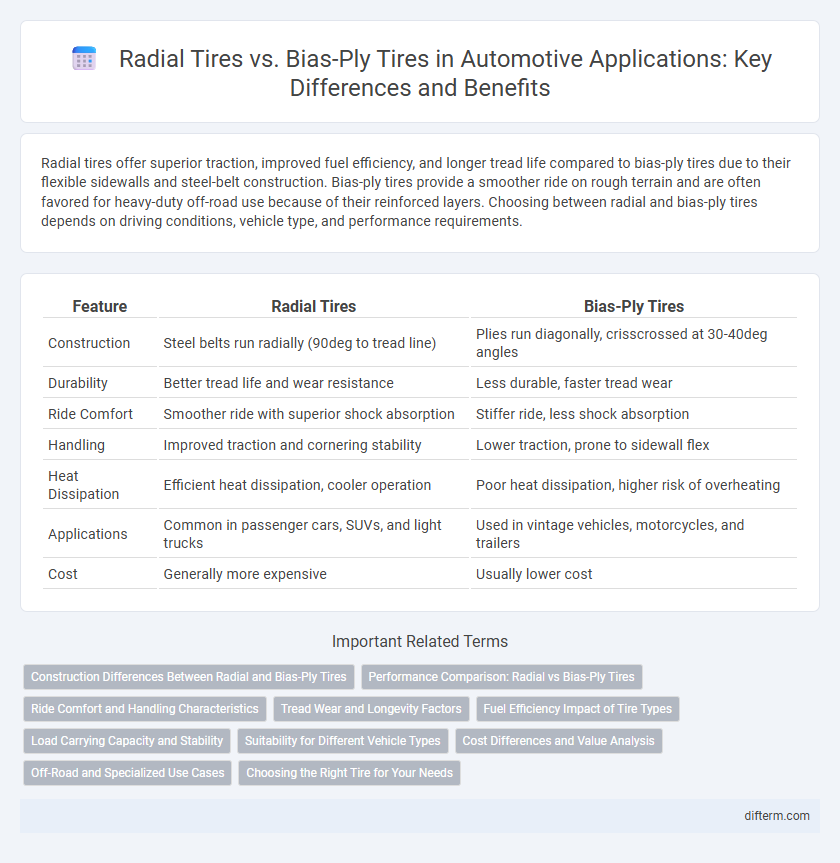Radial tires offer superior traction, improved fuel efficiency, and longer tread life compared to bias-ply tires due to their flexible sidewalls and steel-belt construction. Bias-ply tires provide a smoother ride on rough terrain and are often favored for heavy-duty off-road use because of their reinforced layers. Choosing between radial and bias-ply tires depends on driving conditions, vehicle type, and performance requirements.
Table of Comparison
| Feature | Radial Tires | Bias-Ply Tires |
|---|---|---|
| Construction | Steel belts run radially (90deg to tread line) | Plies run diagonally, crisscrossed at 30-40deg angles |
| Durability | Better tread life and wear resistance | Less durable, faster tread wear |
| Ride Comfort | Smoother ride with superior shock absorption | Stiffer ride, less shock absorption |
| Handling | Improved traction and cornering stability | Lower traction, prone to sidewall flex |
| Heat Dissipation | Efficient heat dissipation, cooler operation | Poor heat dissipation, higher risk of overheating |
| Applications | Common in passenger cars, SUVs, and light trucks | Used in vintage vehicles, motorcycles, and trailers |
| Cost | Generally more expensive | Usually lower cost |
Construction Differences Between Radial and Bias-Ply Tires
Radial tires feature steel belts running perpendicular to the tread with flexible sidewalls, enhancing ride comfort and tire longevity. Bias-ply tires consist of multiple layers of fabric cords arranged diagonally, offering increased sidewall strength but reduced flexibility. This fundamental construction difference affects traction, heat dissipation, and overall vehicle handling characteristics.
Performance Comparison: Radial vs Bias-Ply Tires
Radial tires offer superior traction and handling due to their flexible sidewalls and stronger steel belts, enhancing fuel efficiency and ride comfort when compared to bias-ply tires. Bias-ply tires have stiffer sidewalls and cross-ply construction, resulting in durability on rough terrains but increased rolling resistance and decreased ride smoothness. The choice between radial and bias-ply tires significantly impacts vehicle stability, tire longevity, and overall driving performance in automotive applications.
Ride Comfort and Handling Characteristics
Radial tires provide superior ride comfort due to their flexible sidewalls, which absorb road irregularities more effectively than bias-ply tires. Their construction allows for better handling characteristics, offering enhanced stability and traction, especially at higher speeds and during cornering. Bias-ply tires, with stiffer sidewalls, tend to deliver a rougher ride and less precise handling, making them less suitable for performance-focused driving.
Tread Wear and Longevity Factors
Radial tires exhibit superior tread wear and longevity compared to bias-ply tires due to their steel belt construction, which enhances flexibility and heat dissipation. Bias-ply tires, with overlapping plies, tend to generate more heat and suffer faster tread degradation under high-stress conditions. The improved contact patch and reduced rolling resistance in radial tires contribute to extended tread life and consistent performance over time.
Fuel Efficiency Impact of Tire Types
Radial tires improve fuel efficiency by reducing rolling resistance compared to bias-ply tires, which have stiffer sidewalls and higher energy loss. The flexible construction of radial tires allows better contact with the road, optimizing fuel consumption by up to 3-5%. Automakers increasingly prefer radial tires to enhance vehicle mileage and reduce carbon emissions.
Load Carrying Capacity and Stability
Radial tires offer superior load carrying capacity due to their steel belt construction, which distributes weight evenly and reduces wear. Their flexible sidewalls enhance stability, providing better traction and handling on various road surfaces compared to bias-ply tires. Bias-ply tires, with their crisscrossed fabric layers, generally have lower load capacity and less stability, making them less suitable for high-speed or heavy-load applications.
Suitability for Different Vehicle Types
Radial tires offer superior flexibility and better traction, making them ideal for passenger cars and light trucks used for everyday driving and highway conditions. Bias-ply tires provide enhanced durability and resistance to sidewall damage, which suits heavy-duty vehicles and off-road applications requiring rugged performance. Choosing between radial and bias-ply tires depends on the vehicle's usage, load requirements, and terrain challenges.
Cost Differences and Value Analysis
Radial tires generally cost more upfront than bias-ply tires due to advanced materials and construction techniques that deliver enhanced durability and fuel efficiency. Bias-ply tires offer lower initial prices but tend to wear out faster and provide less traction, leading to higher long-term replacement and maintenance expenses. Evaluating total cost of ownership reveals radial tires offer superior value through prolonged lifespan, improved performance, and reduced fuel consumption, justifying the higher initial investment.
Off-Road and Specialized Use Cases
Radial tires provide superior traction and durability on rough off-road terrains due to their flexible sidewalls and enhanced ground contact, making them ideal for specialized heavy-duty vehicles and all-terrain applications. Bias-ply tires offer increased resistance to punctures and sidewall damage, favored in rugged environments where tire robustness is critical, such as in agricultural or military off-road vehicles. The choice between radial and bias-ply tires hinges on terrain type and usage demands, with radial tires excelling in performance and fuel efficiency, while bias-ply tires prioritize durability and load-bearing capacity.
Choosing the Right Tire for Your Needs
Radial tires offer superior traction, fuel efficiency, and longer tread life due to their flexible sidewalls and steel belt construction, making them ideal for everyday driving and high-speed performance. Bias-ply tires provide enhanced durability and sidewall strength, suitable for off-road conditions and heavy-duty applications where ruggedness is prioritized. Selecting the right tire depends on vehicle type, driving conditions, and performance requirements to balance comfort, safety, and longevity.
radial tires vs bias-ply tires Infographic

 difterm.com
difterm.com